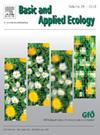Recent technological developments allow for passive acoustic monitoring of Orthoptera (grasshoppers and crickets) in research and conservation across a broad range of temporal and spatial scales
IF 3.5
2区 环境科学与生态学
Q2 ECOLOGY
引用次数: 0
Abstract
Passive acoustic monitoring (PAM) uses stationary recorders to detect wildlife in field conditions. The method has long been valuable for surveying certain species groups, especially bats. However, PAM has been limited by resource costs and availability of automatic classifiers to assist data analysis. With recent developments of inexpensive devices, such as Audiomoth, landscape-scale monitoring has become more feasible. This also opens possibilities to apply PAM to species groups that traditionally have been studied via expert-based, labour-intensive monitoring, such as transect surveys.
Utilizing recordings of Orthoptera from online databases, specialists and from our own recordings, we built a machine-learning classifier to automatically identify 17 Orthoptera species, OrthopterOSS. Assessment included the comparison of PAM to traditional transects surveys. We also compared the performance of inexpensive Audiomoth with classic Batlogger recorders for surveying Orthoptera species with PAM, at eight sites, where we also tested whether adding two additional Audiomoths in 50 m distances from the initial device towards the edge of the wildflower area would increase species detections. We also assessed how the number of species detected changed over time.
In total, we detected 20 Orthoptera species during the study. Our new classifier achieved a true positive rate of 86.4 % validated against independent test data. PAM outperformed traditional sweep netting transects overall, although differences were not statistically significant. There was no difference in species composition detected by Audiomoth v1.2 or Batlogger, the species composition detected by three Audiomoths compared to one Audiomoth and no difference between hedgerow and centre species communities. There was also no significant relationship between Orthoptera richness and the percentage of permanent semi-natural habitat in the nearby landscape.
Relatively inexpensive equipment allows for efficient PAM of Orthoptera. Our OrthopterOSS classifier could represent a useful tool for future PAM research in northern Europe, and serve as an extendable basis for studies elsewhere. If the species predictions are verified by an expert, the classifier could assist monitoring and conservation of Orthoptera at broad temporal and spatial scales.
最近的技术发展允许在广泛的时间和空间尺度上对直翅目(蚱蜢和蟋蟀)的研究和保护进行被动声学监测
被动声监测(PAM)使用固定记录仪在野外条件下探测野生动物。长期以来,这种方法在调查某些物种群体,尤其是蝙蝠方面一直很有价值。然而,PAM受到资源成本和辅助数据分析的自动分类器可用性的限制。随着最近廉价设备(如Audiomoth)的发展,景观级监测变得更加可行。这也为将PAM应用于传统上通过基于专家的劳动密集型监测(如样带调查)进行研究的物种群体提供了可能性。利用在线数据库、专家和我们自己的直翅目记录,我们建立了一个机器学习分类器,用于自动识别17种直翅目物种。评估包括PAM与传统样带调查的比较。我们还比较了便宜的Audiomoth和经典的蝙蝠记录器在8个地点的性能,用于用PAM测量直翅目物种,我们还测试了在从初始设备到野花区边缘的50米距离处增加两个额外的Audiomoth是否会增加物种检测。我们还评估了检测到的物种数量是如何随时间变化的。共检测到20种直翅目昆虫。我们的新分类器在独立测试数据的验证下实现了86.4%的真阳性率。PAM总体上优于传统的扫网样带,尽管差异没有统计学意义。Audiomoth v1.2和Batlogger检测到的物种组成没有差异,3个Audiomoth检测到的物种组成比1个Audiomoth检测到的物种组成没有差异,植物篱和中心物种群落之间没有差异。直翅目物种丰富度与周边景观中永久半自然生境的比例关系不显著。相对便宜的设备允许有效的直翅目PAM。我们的OrthopterOSS分类器可以为北欧未来的PAM研究提供一个有用的工具,并作为其他地方研究的可扩展基础。如果预测得到专家的验证,该分类器将有助于在大的时空尺度上对直翅目进行监测和保护。
本文章由计算机程序翻译,如有差异,请以英文原文为准。
求助全文
约1分钟内获得全文
求助全文
来源期刊

Basic and Applied Ecology
环境科学-生态学
CiteScore
6.90
自引率
5.30%
发文量
103
审稿时长
10.6 weeks
期刊介绍:
Basic and Applied Ecology provides a forum in which significant advances and ideas can be rapidly communicated to a wide audience. Basic and Applied Ecology publishes original contributions, perspectives and reviews from all areas of basic and applied ecology. Ecologists from all countries are invited to publish ecological research of international interest in its pages. There is no bias with regard to taxon or geographical area.
 求助内容:
求助内容: 应助结果提醒方式:
应助结果提醒方式:


